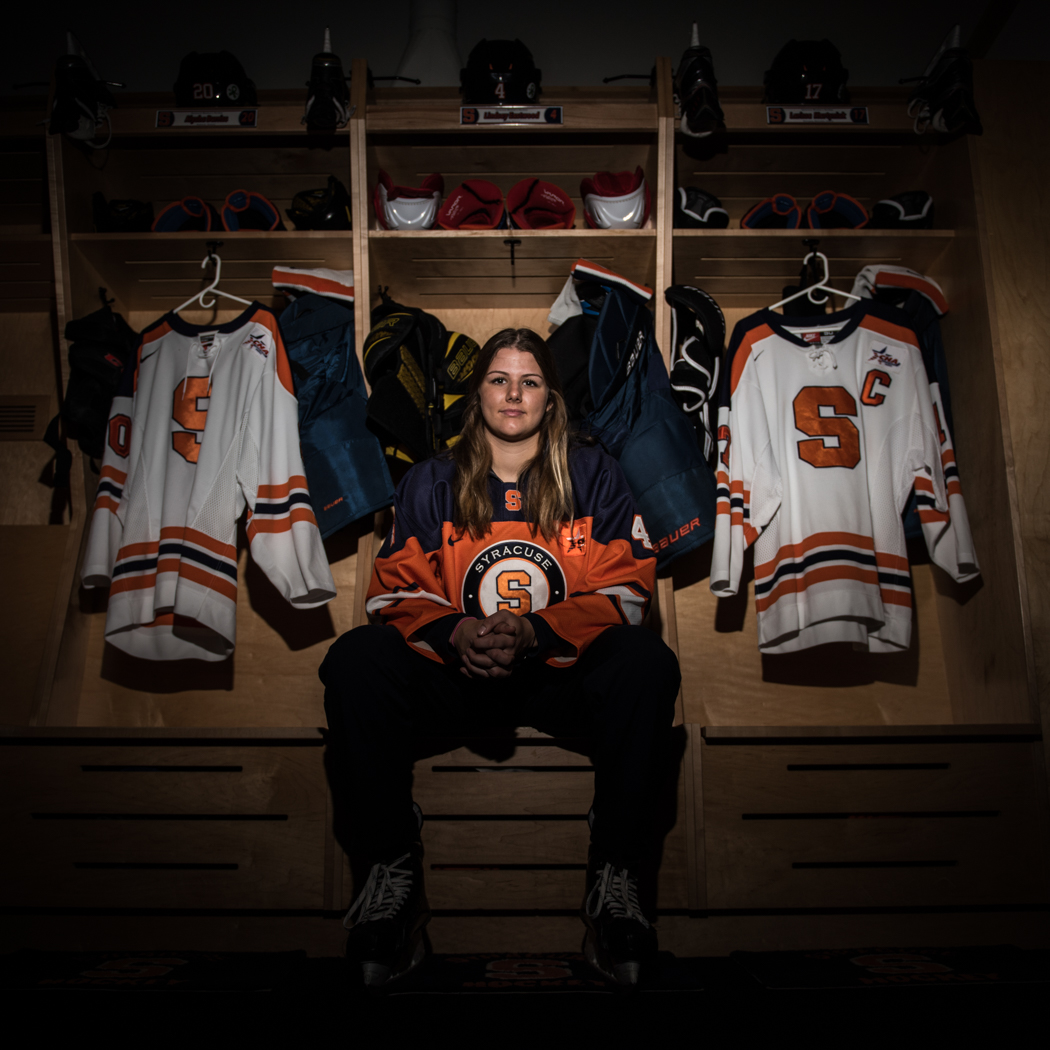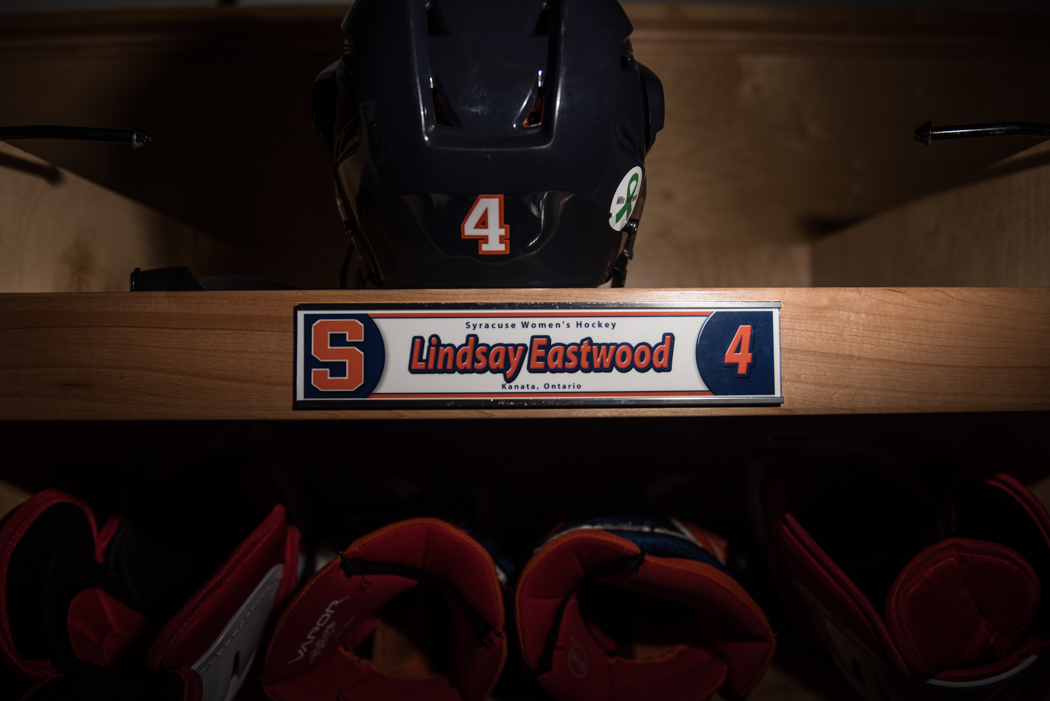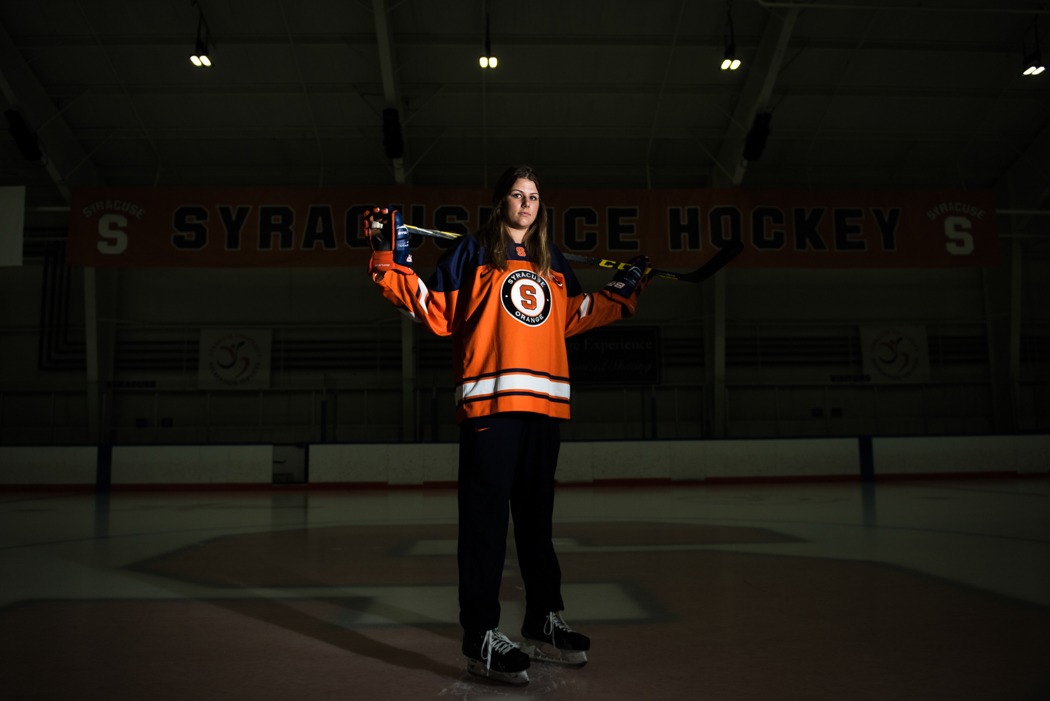D
avid and Kathryn Eastwood walked into the Tennity Ice Pavilion more than an hour before the puck dropped for the Syracuse against Rochester Institute of Technology game.
Neither team was on the ice yet. The Eastwoods took their seats in the bleachers on Dec. 2, right near center ice. Then they waited for their daughter, Lindsay, to take the ice with rest of the SU squad.
“I tell everybody that I talk to, ‘Don’t ever miss your kids stuff,’” David Eastwood said. “Your kids’ sports, that’s gonna happen … and some day, it’s no longer going to be there. And you’re going to miss it.”
He knew that empty feeling too well.
Lindsay, a redshirt freshman who was on the Canada U-18 team while in high school and had Olympic aspirations, missed all of last season. A medical condition discovered just weeks before the school year started prevented her from playing contact sports. There was no reason as to why it happened, but after multiple tests, it appeared like her future hockey career was over.
Her parents tried to help her find other ways to still compete. They encouraged her to try rowing, and Lindsay showed potential in that sport, too. But she still preferred the sport she’d been playing she was six years old.
In August, Lindsay’s rare autoimmune disease unexpectedly reversed itself, even though there was less than a 5 percent chance of that happening. She was cleared to play contact sports again, and is back on the ice with a second chance.
“Oh, it’s pretty cool, man, it’s pretty cool,” David said as he saw his daughter skate on for a line change. “It’s exciting to see her playing again.”
“I never thought we’d be doing this again.”

Bryan Cereijo | Staff Photographer
When the doctor in the emergency room said “blood clots,” after numerous tests in August 2015, it didn’t mean anything to her. But she knew something was wrong when she saw that her mother, a nurse, had a blank expression on her face.
“She’s always so strong and she doesn’t freak out or panic or anything in situations when I’m sick or injured,” Lindsay said. “… When I could see the fear in her eyes, I knew I should start to worry, too.”
Lindsay felt pain in her side and chest. Twice, she went to a physiotherapist, assuming that the discomfort was coming from some sort of pulled muscle or potential back spasms. She even had a professional massage lined up.
With each passing physical test, though, Lindsay’s condition didn’t improve. She felt weak, like she was unable to move. Then she started getting a fever. By the time she was in the ER, she struggled breathing, her parents said.
The original diagnosis was pulmonary emboli: blood clots that travel to the lung. The condition can be life threatening. Syracuse team physician Dr. James Tucker said Eastwood’s youth and fitness contributed to it not being life threatening.
He added the reason he imagines it took so long to diagnose Lindsay with the blood clot was because it wasn’t something doctors looked for. She doesn’t smoke, isn’t overweight and isn’t sedentary for long periods, such as being on airplanes.
“When you see a Canadian Junior Olympic player,” Tucker said, “… (who) says, ‘Well my side hurts,’ well 99 times out of 100, it’s going to be because she does have a pulled muscle.”
Lindsay was given anticoagulants, blood-thinning medication that stops the clots, right away. She felt immediately better when she got the first.
Doctors thought she’d have to be on that medication for about three to six months. She’d be risking her health playing contact sports on blood thinners because it could cause significant internal bleeding, Tucker said. And if she wanted to be taken off the medication, there’d be about an 11 percent chance she’d get another blood clot in her lung and about a 50 percent chance that, if she did, it would be fatal, he added.
By October, the blood clot in her lung had dissolved and by late November, Lindsay prepared for another blood test. Lindsay said she felt normal. Her parents thought about the fastest way to get her back into her practices.
Her parents had packed bags with all her equipment, ready to bring it to Syracuse. The bags stayed home.
The test revealed Lindsay had antiphospholipid syndrome, an autoimmune disease in which the body mistakenly attacks normal proteins in the blood and makes a patient more prone to blood clots in the future.
It’s a rare condition, estimated to affect just 40 to 50 out of 100,000 people each year, according to Medscape.com. It’s considered incurable. It meant blood thinners for life and no hockey.
The Eastwoods were “blindsided.” They had only envisioned the episode in August would keep their daughter out for three months. Now, she wasn’t going to be able to play again. When Dr. Philip Wells, Lindsay’s Canadian thrombosis specialist, gave Lindsay the news, he hugged her and started crying, Kathryn Eastwood said.
… When I could see the fear in her eyes, I knew I should start to worry, too.Lindsay Eastwood
As the year progressed, Lindsay would have her blood tested about every three months to monitor the condition.
“From our point of view, losing hockey at first was nothing, because we could have lost our daughter,” Kathryn said. “But as she got well, and as time went by and she regained her fitness, then we started missing hockey again.”
Watching SU play Boston College in 2015, the last game before a nearly month-long break for the ice hockey team, Lindsay cried realizing she couldn’t be on the ice. When she trained at home over winter break, she remembers going through workouts and thinking to herself, “What am I working toward now?”
SU honored her scholarship, despite the fact that she wouldn’t play.
Lindsay experienced sorrow stronger than she had ever felt. But in the back of her mind she was considering what other sport she could try.
“I’m not ready to not be an athlete yet,” Lindsay remembers thinking. “It’s weird to think you’re upset about one thing, but you have to move forward.”

Bryan Cereijo | Staff Photographer
At an indoor rowing center at Brock University (Ontario), Lindsay pushed herself physically on a bike, where both the arms and the legs have to move, as part of an endurance step test.
Paul Beedling, a talent identification and development coach for Row to Podium, watched Lindsay. Row to Podium is an organization that tests athletes to find ones who can be molded into Olympic-level rowers. David Eastwood had gone online, found the group and arranged the testing after Lindsay briefly mentioned rowing as an interest.
“It goes right until exhaustion, so they can’t maintain the rpm (revolutions per minute),” Beedling said about the step test. “When they get into that territory and they begin to suffer, that’s our first chance to kind of see their mental toughness.”
For female athletes, the test starts off at 50 rpm and every minute the rpm increases by five. The goal is to be able to get to the 80-rpm mark, which would take six full minutes. Coaches look to see who pushes past that mark.
Lindsay rode for seven or eight minutes, Beedling said. Among the roughly 275 kids that he tested that year on the bike test and other exercises, she was one of the 10 best, he said.
They sent results to the Syracuse rowing team. She practiced with the team all spring, but never competed. When she got back home for the summer, she was assigned a one-on-one rowing coach, Laryssa Biesenthal, a bronze medalist in both the 1996 and 2000 Olympic Games.
Playing in team sports her whole life, Lindsay wasn’t used to training alone, and rowing focused on different muscles from those used in hockey.
“I remember the first few weeks with the rowing team I couldn’t believe I made it through it,” Lindsay said.
Getting into a boat was tricky for her, too. It was wobblier than she thought it’d be. But she kept at it and by mid-July, she felt comfortable rowing.
Biesenthal thinks Lindsay has potential to be Olympian. And Lindsay was ready to use rowing as her path to the Olympics.
“I wouldn’t say I’d gotten over hockey at that point,” Lindsay said. “But I had moved on.”

Bryan Cereijo | Staff Photographer
When David Eastwood returned home one day in mid-August, he saw Kathryn and Lindsay walking toward the door to greet him, both crying.
“I’m walking and I’m going ‘What the hell just happened,’” David said. “‘Did somebody die in our family?’”
They were celebrating that Lindsay’s last blood test had come back negative. Almost a year to the day after her diagnosis, her antiphospholipid syndrome had disappeared.
That specific blood test only happened because SU asked for it. Wells, the doctor, stressed to them not to get their hopes up.
“All the other blood tests that we ever did, and there were many, we were holding our breaths and really hoping that it would change,” Kathryn said. “And this was the first time we weren’t even thinking about it because we didn’t think there was any possibility of it changing at this stage.”
Eventually, Kathryn, who works at the same hospital where the tests were conducted, received the rest results.
She came home, gave Lindsay the news and the two hugged. Then Kathryn watched her daughter run around the house in joy. A few minutes later, Lindsay called SU ice hockey head coach Paul Flanagan. She told him she was eligible to return.
“It was like disbelief with happiness, but you’re still guarded,” Kathryn said. “You still think, ‘Really? Is this for real?’”
Then, to double check and confirm the first test wasn’t a fluke, Lindsay had a second test done several weeks later at SU. Negative, again.
It was like disbelief with happiness, but you’re still guarded.You still think, ‘Really? Is this for real?’Kathryn Eastwood
After the ecstasy of the moment subdued, Lindsay felt overwhelmed. She wasn’t prepared to play hockey. She thought she’d never play again.
“I haven’t been sprinting, and here I’m thinking I’ll never have to sprint again because I’m not a fan of that,” Lindsay said.
She ended up going on the ice to practice every day for the next two weeks to catch up before returning to campus.
Before Lindsay’s first preseason game, Kathryn bought her daughter an Alex and Ani brand bracelet with a charm hanging on it. The various bracelets and charms that Alex and Ani sell have different names for different things they represent. The one Kathryn bought represented “unexpected miracles.”
Now she feels back to her level of play before the illness. She’s put rowing to the side as she focuses on hockey, but she might pick up rowing again later in life.
The game against RIT went into overtime. With three seconds left, Lindsay fired a shot from in front of the net. It was deflected and hit the boards as the buzzer sounded.
David jumped up and yelled “Ah Lindsay, so close,” let down that Syracuse, and Lindsay, didn’t win the game.
But the disappointment didn’t last long. She had a chance to score a game-winning goal. She’d be able to play again the following day. And she had her parents there, watching her.
That all seemed impossible five months ago.
“I think she’s getting sick of us,” Kathryn joked about their attendance at all the games. “Because we’re not missing anything.”
Banner photo by Bryan Cereijo
Published on December 10, 2016 at 7:06 pm
Contact Tomer: tdlanger@syr.edu | @tomer_langer


